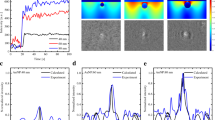Abstract
The conditions under which the localized surface plasmon resonance (LSPR) model can be applied to the calculation of surface-enhanced Raman scattering (SERS) enhancement factors have been questioned because the chemical effect presents simultaneously with LSPR effect, resulting in calculations that are not always consistent with the measured data. The SERS spectra of crystal violet (CV) molecules on single, dimer, trimer, and aggregates of silver microparticles surface-modified with nanostructures (MSMN) were obtained. It is found that the chemical effect is determined by the chemical adsorption behavior of CV molecules on single particle. As more particles are introduced as amplifiers, to assemble dimer, trimer, and aggregates, no new SERS signals related to the chemical effect can be observed, except for the further enhancement to the original signals. The further enhancement is attributed to the LSPR effect from the electromagnetic coupling with introduced particles. This is also demonstrated by dark field scattering. The LSPR theoretical values of single, dimer, trimer, and aggregates of MSMNs should fit the measured enhancement factor (G LSPR) after correcting the SERS enhancement factor (G SERS) with the chemical enhancement factor on the single particle (G Chem-Sgl), i.e., G LSPR = G SERS/G Chem-Sgl. Tip-enhanced Raman spectroscopy with a gold nanoparticle further implies that this could be extended to nanoparticle systems. This work provides an effective and simple route, whereby only the chemical effect from a single particle needs to be considered when studying the fit between the LSPR model and the measured LSPR enhancement factor.






Similar content being viewed by others
References
Alvarez-Puebla RA, Liz-Marzán LM (2010) SERS-based diagnosis and biodetection. Small 6:604–610
Xu HX (2004) Theoretical study of coated spherical metallic nanoparticles for single-molecule surface-enhanced spectroscopy. Appl Phys Lett 85:5980–5982
Zhou Z, Huang GG, Kato T, Ozaki Y (2011) Experimental parameters for the SERS of nitrate ion for label-free semi-quantitative detection of proteins and mechanism for proteins to form SERS hot sites: a SERS study. J Raman Spectrosc 42:1713–1721
Yang LK, Li ZP, Wang PJ, Zhang LS, Fang Y (2014) Optical properties of noncontinuous gold shell engineered on silica mesosphere. Plasmonics 9:121–127
Wang PJ, Zhang D, Li LL, Li ZP, Zhang LS, Fang Y (2012) Reversible defect in graphene investigated by tip-enhanced Raman spectroscopy. Plasmonics 7:555–561
Nauert S, Paul A, Zhen YR, Solis D Jr, Vigderman L, Chang WS, Zubarev ER, Nordlander P, Link S (2014) In fluence of cross sectional geometry on surface plasmon polariton propagation in gold nanowires. ACS Nano 8:572–580
Li ZP, Bao K, Fang YR, Huang YZ, Nordlander P, Xu HX (2010) Correlation between incident and emission polarization in nanowire surface plasmon waveguides. Nano Lett 10:1831–1835
Hirsch LR, Stafford RJ, Bankson JA, Sershen SR, Rivera B, Price RE, Hazle JD, Halas NJ, West JL (2003) Nanoshell-mediated near-infrared thermal therapy of tumors under magnetic resonance guidance. Proc Natl Acad Sci U S A 100:13549–13554
Vendrell M, Maiti KK, Dhaliwal K, Chang YT (2013) Surface-enhanced Raman scattering in cancer detection and imaging. Trends Biotechnol 31:249–257
Yuan H, Fales AM, Khoury CG, Liu J, Vo-Dinh T (2013) Spectral characterization and intracellular detection of surface-enhanced Raman scattering (SERS)-encoded plasmonic gold nanostars. J Raman Spectrosc 44:234–239
Potara M, Gabudeana AM, Astilean S (2011) Solution-phase, dual LSPR-SERS plasmonic sensors of high sensitivity and stability based on chitosan-coated anisotropic silver nanoparticles. J Mater Chem 21:3625–3633
Guillot N, Shen H, Frémaux B, Péron O, Rinnert E, Toury T, Lamy de la Chapelle M (2010) Surface enhanced Raman scattering optimization of gold nanocylinder arrays: influence of the localized surface plasmon resonance and excitation wavelength. Appl Phys Lett 97:023113
Otto A (2005) The ‘chemical’ (electronic) contribution to surface-enhanced Raman scattering. J Raman Spectrosc 36:497–509
Zhang X, Wang PJ, Zhang LZ, Fang YR, Sun MT (2014) Plasmon-driven sequential chemical reactions in an aqueous environment. Sci Rep 4:5407
Liang HY, Li ZP, Wang WZ, Wu YS, Xu HX (2009) Highly surface-roughened “flower-like” silver nanoparticles for extremely sensitive substrates of surface-enhanced Raman scattering. Adv Mater 21:4614–4618
Choi HK, Shon HK, Yu H, Lee TG, Kim ZH (2013) b2 peaks in SERS spectra of 4-aminobenzenethiol: a photochemical artifact or a real chemical enhancement? J Phys Chem Lett 4:1079–1086
Kim K, Shin D, Kim KL, Shin KS (2012) Surface-enhanced Raman scattering of 4,4′-dimercaptoazobenzene trapped in Au nanogaps. Phys Chem Chem Phys 14:4095–4100
Acknowledgments
This work was supported by the National Science Foundation of China (No. 11204189).
Author information
Authors and Affiliations
Corresponding author
Rights and permissions
About this article
Cite this article
Zhang, H., Yang, S., Zhou, Q. et al. The Suitable Condition of Using LSPR Model in SERS: LSPR Effect Versus Chemical Effect on Microparticles Surface-Modified with Nanostructures. Plasmonics 12, 77–81 (2017). https://doi.org/10.1007/s11468-016-0231-4
Received:
Accepted:
Published:
Issue Date:
DOI: https://doi.org/10.1007/s11468-016-0231-4




